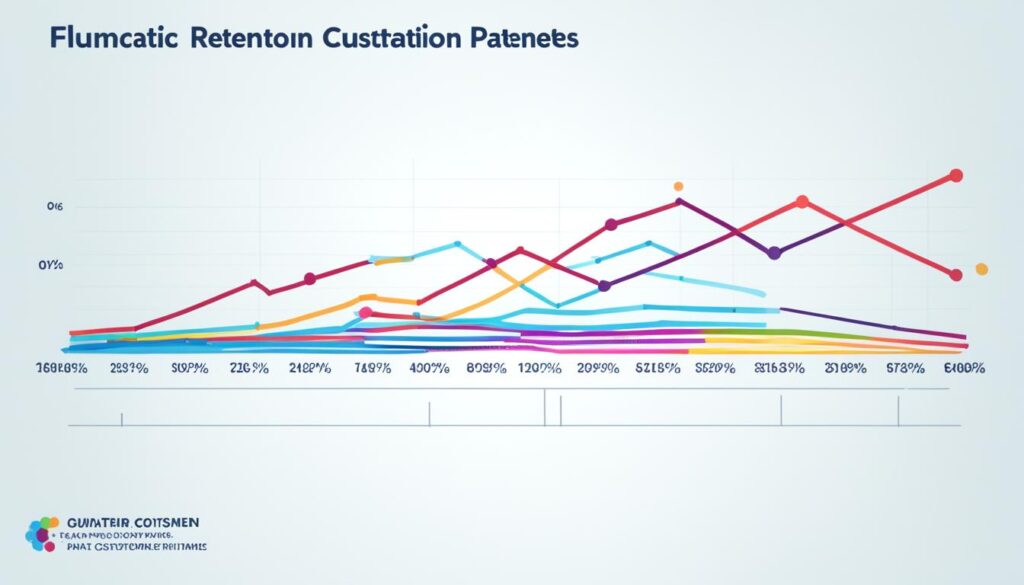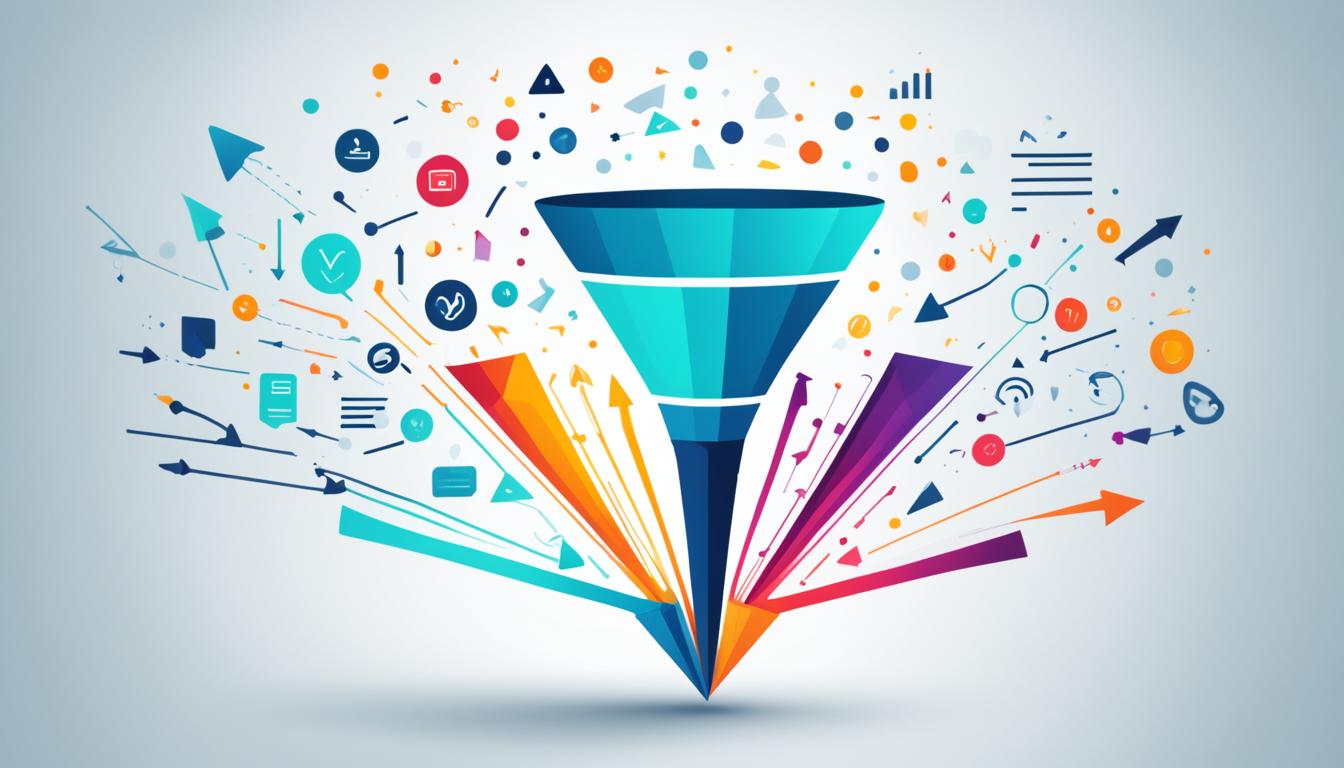The subscription economy has witnessed unprecedented growth in recent years, with a staggering 300% increase between 2012 and 2019. In this era of data-driven insights, businesses are discovering the power of leveraging big data to improve customer loyalty and retention.
Subscription and loyalty programs have proven to be highly effective in boosting customer retention and increasing customer lifetime value. By analyzing customer data, businesses gain valuable insights into customer behavior and preferences, enabling them to personalize engagement strategies and create meaningful experiences.
Key Takeaways:
- Data-driven strategies are essential for boosting customer loyalty and retention.
- Subscription and loyalty programs offer recurring touchpoints and create a sense of brand loyalty.
- Personalizing engagement strategies based on customer data leads to stronger customer relationships.
- Using big data enables businesses to identify opportunities to prevent churn and retain valuable customers.
- By leveraging customer insights, businesses can improve customer satisfaction, loyalty, and revenue.
The Relationship Between Subscriptions and Loyalty
Loyalty programs often include a subscription element, while subscription services incorporate conventional loyalty principles. These two approaches work in tandem to create value for customers, fostering brand loyalty and driving customer-centric decision-making. Let’s explore how subscriptions and loyalty programs intertwine to create a symbiotic relationship.
The Value of Subscriptions in Fostering Brand Loyalty
Subscription-based models have become increasingly popular in today’s subscription economy. Customers are drawn to the convenience, predictability, and data insights that subscriptions offer. By signing up for regular deliveries or access to exclusive content, customers establish ongoing relationships with brands, building a foundation for loyalty.
Subscription services often provide additional perks, such as discounts, personalized recommendations, and early access, further incentivizing customers to remain loyal. This reciprocity cultivates a sense of trust and commitment, strengthening the bond between customers and brands.
The Role of Loyalty Programs in Subscription Services
Conversely, loyalty programs frequently incorporate a subscription element, offering exclusive benefits to incentivize continued patronage. Customers can unlock higher-tier memberships or receive additional rewards by subscribing to a brand’s loyalty program.
By integrating subscription elements into loyalty programs, brands tap into the growing trend of consumers seeking discounts, rewards, and exclusive partnerships. This convergence allows brands to leverage the advantages of both loyalty programs and subscriptions, providing customers with a comprehensive experience that drives loyalty and fosters long-term relationships.
Boosting Customer Retention through Subscriptions and Loyalty
Given the tangible value offered by subscription and loyalty programs, it’s no surprise they contribute significantly to customer retention. The convenience, customized experiences, and added benefits create a customer-centric environment that promotes retention and reduces the likelihood of churn.
Moreover, the data insights derived from subscription and loyalty programs enable brands to make customer-centric decisions. By understanding customer preferences, behaviors, and purchase patterns, brands can tailor their offerings and engagement strategies, resulting in greater customer satisfaction and increased retention.
| Benefits of Subscriptions and Loyalty Programs for Customer Retention | Examples |
|---|---|
| Convenience and predictability | – Regular deliveries of essential products or services – Access to exclusive content – Automatic renewal for hassle-free experiences |
| Data insights and personalization | – Customized recommendations based on customer preferences – Tailored promotions and discounts – Targeted communication via personalized emails |
| Added value and benefits | – Exclusive partnerships and collaborations – Early access to new products or features – Priority customer support |
By leveraging the combined power of subscriptions and loyalty programs, brands can create a customer-centric ecosystem that nurtures loyalty, maximizes customer retention, and drives business growth.

The Psychology of Subscriptions
Subscriptions hold a powerful emotional draw, enticing customers to join loyalty programs and fostering a deep sense of belonging to both a brand and a community. This emotional connection creates a strong bond between customers and the brand, driving customer loyalty and ultimately reducing customer acquisition costs.
Subscribers enjoy the convenience and reliability that come with subscription models. By subscribing to a service or product, customers can access it easily and regularly without the hassle of repeated purchases or transactions. This convenience factor plays a crucial role in enhancing the overall customer experience and satisfaction.
One key aspect of subscriptions is the opportunity for exclusive partnerships and personalized experiences. Brands often collaborate with other companies to offer exclusive benefits, discounts, or rewards to their loyal subscribers. These special partnerships create a sense of exclusivity and make customers feel valued, further strengthening their bond with the brand.
“Subscriptions provide a unique opportunity for brands to nurture enduring relationships with their customers.”
Subscription models require ongoing nurturing and attention to maintain customer engagement. Brands must consistently deliver high-quality products or services and continuously enhance the subscription experience through personalization and innovation. By doing so, brands can build enduring partnerships with their customers, fostering loyalty that extends beyond individual transactions.
By understanding the psychology behind subscriptions, brands can tap into the emotional draw, the convenience factor, and the desire for enduring relationships to drive customer loyalty. The ability to deliver personalized experiences and build strong connections with subscribers is key to creating a loyal customer base and achieving long-term success.
Let’s visualize this concept with the following table:
| Key Factors | Benefits |
|---|---|
| Emotional draw | Creates a sense of belonging and loyalty |
| Convenience | Easy access to products or services |
| Exclusive partnerships | Access to unique benefits and experiences |
| Enduring relationships | Builds lasting connections with customers |

Understanding the psychology behind subscriptions is essential for businesses seeking to enhance customer loyalty and retention. By leveraging the emotional draw, convenience, exclusive partnerships, and fostering enduring relationships with their customers, brands can create a loyal customer base that drives long-term success.
Subscriptions Drive Customer Retention
Increasing customer retention rates is vital for the growth and profitability of retail brands. Subscription-based businesses, in particular, have shown impressive results in driving customer loyalty and achieving higher profitability compared to traditional businesses. On average, subscription-based businesses grow at a rate five times faster than their counterparts.
Rather than solely focusing on customer acquisition, businesses should prioritize retention efforts. Acquiring new customers is costly, while retaining existing ones can lead to significant profit growth. By collecting and analyzing customer data, companies can identify opportunities to prevent churn and retain valuable customers.
Subscription-based businesses have a competitive advantage when it comes to customer retention. The subscription model offers a recurring revenue stream and an ongoing relationship with customers, which creates a stronger bond and increases the likelihood of repeat purchases. Additionally, subscription-based businesses can leverage customer data to personalize offers, tailor experiences, and provide value-added services.
By prioritizing customer retention and leveraging subscription-based models, businesses can generate sustainable growth, boost customer loyalty, and drive higher profits.
An example of a subscription-based business that has successfully utilized customer retention strategies is Netflix. With its subscription-based streaming service, Netflix has been able to retain a large customer base by constantly offering new content, personalized recommendations, and a seamless user experience. The result is a loyal customer base that continues to generate revenue and contribute to the company’s ongoing success.
Profit Growth of Subscription-Based Businesses vs. Traditional Businesses
| Subscription-Based Businesses | Traditional Businesses | |
|---|---|---|
| Average Growth Rate | 5x faster | Slower |
| Profit Margin | Higher | Lower |
| Customer Lifetime Value | Longer and more valuable | Shorter and less valuable |

The table above illustrates the notable differences in profit growth between subscription-based and traditional businesses. Subscription-based businesses experience a significantly higher growth rate, maintain higher profit margins, and have longer and more valuable customer lifetime value. These findings highlight the importance and impact of customer retention in driving sustainable growth for subscription-based businesses.
Personalized Upselling, Cross-Selling and Marketing to Subscribers
Subscription and loyalty programs provide businesses with a wealth of valuable first-party data that can be leveraged to personalize marketing efforts. By utilizing this customer data, companies can create tailored promotions, implement effective upselling and cross-selling strategies, and develop targeted marketing campaigns that resonate with their subscribers.
Effective personalization involves using customer data to deliver relevant and personalized experiences that meet the specific needs and preferences of each individual subscriber. By analyzing customer data, businesses can gain valuable insights into customer behavior, purchase history, and engagement patterns, allowing them to understand what products or services are most likely to appeal to each subscriber. Armed with this knowledge, businesses can effectively upsell and cross-sell products, increasing the average order value and driving revenue.
One example of personalization in upselling and cross-selling can be seen in the fashion industry. Online clothing retailers can leverage customer data, such as past purchases and browsing history, to recommend complementary products or suggest upgrades to higher-priced items. By tailoring these recommendations to each individual subscriber, businesses can enhance the customer experience, improve customer satisfaction, and drive sales.
Additionally, personalization enables businesses to create targeted marketing campaigns that engage subscribers on a deeper level. By understanding customer preferences, interests, and demographics, businesses can create highly relevant and compelling marketing messages that speak directly to the individual subscriber. This targeted approach increases the likelihood of customer engagement, conversion, and long-term loyalty.
Benefits of Personalized Upselling, Cross-Selling, and Marketing:
- Increased customer satisfaction and loyalty
- Higher revenue through upselling and cross-selling
- Improved customer engagement and conversion rates
- Enhanced customer experience and personalization
By harnessing the power of personalization and leveraging customer data, businesses can create meaningful connections with their subscribers, foster loyalty, and drive revenue growth. It is crucial for businesses to invest in robust data analytics tools and customer data management systems to effectively collect, analyze, and utilize customer data for personalized marketing strategies.
“Personalization is not just about making a sale; it’s about creating lasting relationships with your subscribers and providing them with tailored experiences that meet their unique needs.”
– Jane Johnson, Marketing Director at ABC Company
When done right, personalized upselling, cross-selling, and marketing not only benefit businesses but also enhance the overall customer experience. By leveraging customer data, businesses can offer relevant products and promotions that genuinely satisfy the needs and desires of their subscribers, resulting in increased customer satisfaction, loyalty, and long-term success.
Analyzing Customer Loyalty with Data
Understanding and measuring customer loyalty is vital for businesses striving to build lasting relationships with their customers. By utilizing customer loyalty analytics and key metrics, companies can gain valuable insights into customer behavior and make data-driven decisions to enhance loyalty and drive long-term success.
One of the key metrics for measuring customer loyalty is the customer retention rate. This metric helps businesses understand the percentage of customers who continue to engage with their brand over a specific period. A high customer retention rate indicates strong loyalty, while a low rate may highlight potential areas for improvement.
Another important metric is the net promoter score (NPS), which measures the likelihood of customers recommending a brand to others. NPS provides valuable insights into customer satisfaction and advocacy, enabling businesses to assess the effectiveness of their loyalty initiatives and identify areas for growth.
Customer satisfaction is a crucial component of loyalty, and the customer satisfaction score (CSAT) offers a way to measure it. CSAT surveys assess customers’ satisfaction levels based on their experiences with a brand’s products or services. By regularly measuring CSAT, businesses can identify areas where they may be falling short and take corrective actions to improve satisfaction and loyalty.
Additionally, the customer effort score (CES) measures the ease of the customer journey and the level of effort required to interact with a brand. By assessing the customer effort score, businesses can identify pain points, streamline processes, and create frictionless experiences that promote loyalty.

Customer loyalty analytics enable businesses to dig deeper into customer data and uncover valuable insights. These insights help identify at-risk customers who may be on the verge of churn, allowing proactive measures to be taken to retain their loyalty. Analytics also help track engagement rates, measure the effectiveness of loyalty programs, and provide data-backed strategies for strengthening customer relationships.
By leveraging customer loyalty analytics, businesses can gain a comprehensive understanding of customer behavior, measure loyalty metrics, and identify areas for improvement. This data-driven approach empowers companies to develop strategies that optimize customer retention, satisfaction, and overall loyalty.
Customer Retention Strategies
To retain and engage customers effectively, a variety of strategies can be implemented. By offering personalized customer journeys, targeted campaigns for first-time buyers, and engaging inactive customers, businesses can improve their retention rates. Additionally, identifying at-risk customers and delivering tailored messages based on their interactions with the brand can help prevent churn. Utilizing customer data platforms (CDPs), companies can collect and analyze valuable customer data to drive these retention strategies.
Personalized Customer Journeys
Creating personalized customer journeys is essential to capturing the attention and loyalty of first-time buyers. By tailoring the experience to each individual’s preferences and needs, businesses can enhance customer satisfaction and increase the likelihood of repeat purchases. Implementing marketing automation and customer segmentation can aid in delivering targeted and relevant content at every stage of the customer journey.
Targeted Campaigns for First-Time Buyers
First-time buyers are crucial to a business’s growth and success. Designing targeted campaigns specifically for this segment can help establish a positive initial experience and foster brand loyalty. Offering personalized discounts, incentives, or exclusive content can entice first-time buyers to make repeat purchases and become long-term customers.
Engaging Inactive Customers
Reviving the interest of inactive customers is an effective way to boost customer retention rates. By sending personalized re-engagement emails, offering special promotions, or providing unique content, businesses can regain the attention and loyalty of these customers. Utilizing customer behavior and purchase history data can help tailor these re-engagement efforts to align with their interests and preferences.
Remember, retaining customers is just as crucial as acquiring new ones. By implementing personalized customer journeys, targeted campaigns, and re-engagement strategies, businesses can maximize their efforts in retaining valuable customers and driving long-term success.
Identifying At-Risk Customers
Identifying customers who are at risk of churning is vital to proactive customer retention. By analyzing customer data such as purchase frequency, browsing patterns, and engagement metrics, businesses can identify warning signs of potential churn. Once at-risk customers are identified, tailored messages and offers can be delivered to re-engage them and prevent them from leaving. This personalized approach shows customers that their needs and concerns are valued, fostering a stronger relationship with the brand.
Conclusion
Customer loyalty and retention are essential for the success of any business. By implementing data-driven strategies that leverage customer insights, brands can cultivate personalized experiences that foster customer loyalty.
Subscription and loyalty programs, along with targeted marketing campaigns, play a crucial role in retaining and engaging customers. These initiatives provide recurring touchpoints and create a sense of brand loyalty, ultimately increasing customer lifetime value.
Through the use of customer data, businesses can develop a deep understanding of their customers’ preferences, behaviors, and needs. This valuable data enables companies to create personalized experiences, tailor promotions, and deliver targeted messages that resonate with their customers.
By adopting data-driven strategies and leveraging customer insights, businesses can build enduring relationships, prevent churn, and drive long-term success. Customer loyalty and retention, achieved through effective subscription and loyalty programs, personalized marketing, and customer journeys, are key to maximizing revenue and securing a strong position in the market.
FAQ
How can data help boost customer loyalty?
Data analysis plays a crucial role in understanding customer behavior and personalizing engagement strategies. By collecting and analyzing customer data, companies can identify opportunities to prevent churn and retain valuable customers. Subscriptions and loyalty programs provide valuable first-party data that can be used to personalize marketing efforts and create targeted campaigns.
How do subscriptions and loyalty programs contribute to customer loyalty?
Subscriptions create an emotional draw for customers to join loyalty programs and strengthen the sense of belonging to a brand and a community. Subscribers benefit from convenience, reliability, and personalized experiences. Subscription models require nurturing but foster enduring partnerships between customers and brands, leading to customer loyalty and reduced acquisition costs.
What is the impact of customer retention on business profitability?
Increasing customer retention rates can lead to significant profit growth for retail brands. Subscription-based businesses, on average, grow at a rate five times faster than traditional businesses and demonstrate higher profitability. Retention efforts are essential as it is more expensive to acquire new customers than to retain existing ones.
How can customer loyalty be measured?
Customer loyalty can be analyzed through a multifaceted approach. Key metrics include customer retention rate, net promoter score (NPS), customer satisfaction score (CSAT), and customer effort score (CES). Customer loyalty analytics help identify at-risk customers, measure satisfaction levels, and track engagement rates.
What strategies can be employed to retain and engage customers?
Various strategies can be employed to retain and engage customers, such as personalized customer journeys, targeted campaigns for first-time buyers, and engaging inactive customers. Identifying at-risk customers and delivering tailored messages based on their interactions with the brand can help prevent churn. Customer data platforms (CDPs) play a crucial role in collecting and analyzing customer data to drive effective retention strategies.
What are the benefits of personalized marketing to subscribers?
Personalized marketing to subscribers allows companies to leverage customer insights and provide tailored experiences. This enables companies to upsell and cross-sell products, tailor promotions, and create targeted marketing campaigns. By offering personalized experiences and leveraging customer insights, brands can increase customer satisfaction, loyalty, and revenue.
How can data-driven retention strategies be used to drive long-term success?
Data-driven strategies that leverage customer insights and provide personalized experiences are key to boosting loyalty. Retaining and engaging customers through subscription and loyalty programs, personalized marketing, and effective customer journeys can lead to increased customer lifetime value and long-term success for businesses.








